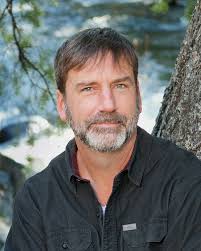Cascadia Field Guide invites us to experience nature around us in a fresh new way
Derek Sheffield, a poet, naturalist and Wenatchee Valley College professor, was kind enough to give me a copy of a remarkable new book he helped edit and write, Cascadia Field Guide, and I have been unable to put it down or stop thinking about it.
Cascadia Field Guide is changing the superficial way I have tended to think about the natural environment we share with so many other beings. It’s a blend of art and science that evokes a deeper understanding and appreciation of the interconnectedness of life. On April 20th, in celebration of Earth Day and Poetry Month, there will be a launch party for the book at Wenatchee Valley College in the Grove Recital Hall from 1 to 2 PM.
Five years in the making, this creative literary work explores the ecology of the Cascadia bioregion, which is defined by the Sightline Institute as “the watersheds of rivers that flow into the Pacific Ocean through North America’s temperate rainforest zone. The region extends from southern Alaska to northern California and from the Pacific Ocean to the continental divide.
Unlike typical field guides that focus solely on the details of plants and animals, Cascadia Field Guide looks at beings (including humans) through a wider cultural lens, drawing upon Indigenous/First Nations/Native American knowledge and other historical contexts.
Another aspect that makes this guide different is that it is organized into 13 communities, such as Urban Shore, Eastern Rivers, Pine Forest and Shrub Steppe. Each community has a general description followed by entries of signature plants, animals, trees and fish. Each of those entries is accompanied by original artwork and a poem.
For a reader, this organic approach fires the spark of imagination for readers in a way that traditional field guides cannot. One cannot help but be drawn in by the interconnectedness of life throughout its pages.
Sheffield, in an interview with Paisley Rekdal of High Country News recently, said he and fellow editors Elizabeth Bradfield, CMarie Fuhrman, combed through thousands of poems created by poets in the Cascadia region to choose the ones to be included in the guide.
For the entries without existing poems, they invited poets from Cascadia to put their creative juices into original work.
The editors went to great lengths to capture voices from a diversity of perspectives — ”urban and rural, Native and settler, Canadian and American — and diversities of gender, race, sexuality and more,” according to the book’s introduction. That same commitment to engaging diverse perspectives extended to the selection of artists to illustrate the different sections.
The editors chose to use the term ‘beings’ rather than ‘species’ throughout the book. “We like that word for its texture, its vitality, its agency, as opposed to species, which just feels a little bit more clinical and laboratory to us,” Sheffield told Rekdal.
This book is shifting my outlook. Absorbing the stories and connections in the Cascadia Field Guide has encouraged me to think more deeply about the world in which we live.
As a society, we have become increasingly disconnected from the natural world around us, as if we were separate from nature. Nature has become “natural resources” — commodities to be used and consumed. We need affirmative reminders that this duality is a myth, that we are part of the larger system of life, and that our fate as beings is dependent on the well-being of the entire system.
Cascadia Field Guide, a meditation on the web of life around and within us, offers us a way of thinking about our world as well as the guidance and tools for deeper understanding. If you’re interested in acquiring the book, please reach out to your local bookstore and support the local ecosystem of businesses. You can listen to the High Country News interview here: https://twitter.com/i/spaces/1DXxyvODYEVKM?s=20



